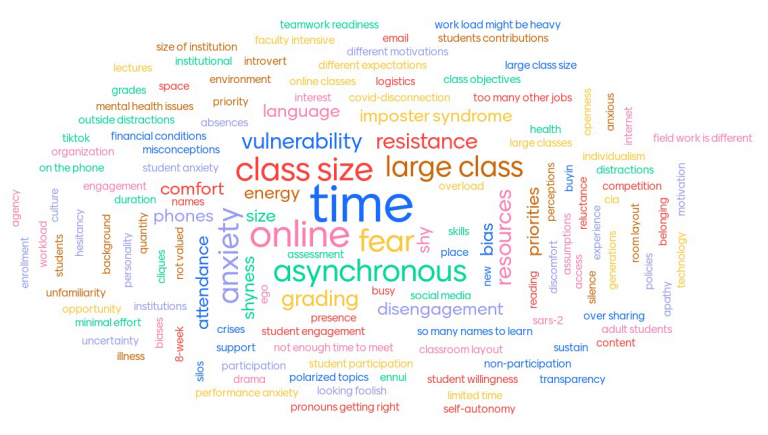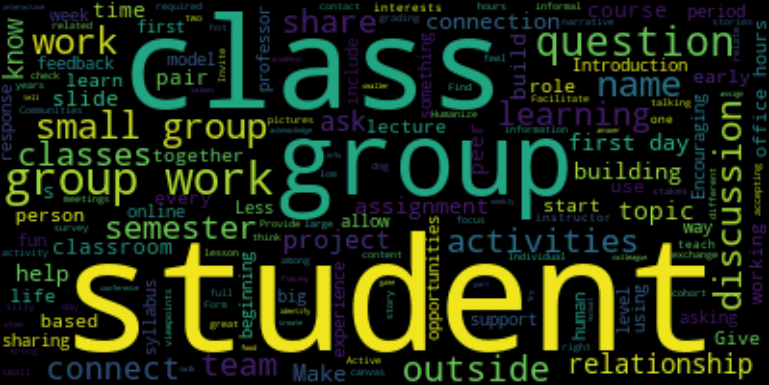
Peter Felten’s keynote message about building relationships through teaching found a receptive audience at this year’s Teaching Summit.
Felten, a professor of history and assistant provost for teaching and learning at Elon University, shared the stories of students who had made important connections with instructors and fellow students while at college. He used those stories to talk about the importance of humanity in teaching and about the vital role that community and connection make in students’ lives.
As part of his talk, Felten encouraged attendees to share examples of how they humanize their classes, asking:
What do you do to build relationships with and among students?
Summit attendees submitted about 140 responses. Felten shared some of them, along with a word cloud, but they were on screen only briefly. I thought it would be useful to revisit those responses and share them in a form that others could draw on.
To do that, I started with a spreadsheet from Felten that provided all the responses. I categorized most of them manually but also had ChatGPT create categories and a word cloud. Some responses had two or three examples, so I broke those into discrete parts. After editing and rearranging the categories and responses, I came up with the following list.
- Use collaborative work, projects, and activities
- Humanize yourself and students
- Learn students’ names
- Use ice breakers or get-to-know-you activities
- Create a comfortable environment and encourage open discussions
- Meet students individually
- Use active learning
- Provide feedback
- Engage students outside of class
Many of the responses could fit into more than one category, and some of the categories could certainly be combined. The nine I ended up with seemed like a reasonable way to bring a wide-ranging list of responses into a more comprehensible form, though.
Here’s that same list again, this time with example responses. It’s worth a look, not only to get new ideas for your classes but to reinforce your approaches to building community.

Use collaborative work, projects and activities
- Pulling up some students’ burning questions for small group discussions and then full class discussion leading to additional explanation and information in class.
- Think-pair-share in large lectures so students have several opportunities to connect with each other in different sized groups.
- Group work in consistent teams.
- We have a small cohort model that keeps students together in a group over two years and allows us to have close relationships with the students naturally.
- Timed “warm-up” conversations in pairs, usually narrative-based, often related to lesson/topic in some way; I always partner with someone, too.
- Form three-person groups early in the semester on easy assignments so the focus is on building relationships with each other.
- Group projects with milestones.
- Team-based learning.
- Using CATME to form student groups, which allows students to work in groups during class and facilitates group work and other interactions outside of class.
- Put students in small groups, give them a problem, ask them to solve it, and have them report back to the class.
- Group work in classrooms and online, in particular.
Humanize yourself and students
- Provide them your story to humanize your experience and how it may relate to theirs.
- Make myself seem more human, less intimidating. Share about myself outside of my role as professor makes students feel more comfortable to approach me and willingness to build that connection.
- I start class by sharing something about myself, especially something where I failed. The intention is to normalize failure and ambiguity. I also have a big Spider-Man poster in my office!
- Casually talking to the students about themselves, not only talking about the class or class-related topics.
- Being approachable by encouraging them to ask questions.
- Find topics of mutual connection – ex. International students and missing food from home.
- I tell my story as a first-generation student from rural America on day one. Try to be a human!
- Admit my own weaknesses and struggles!
- For groups that will be working together throughout the semester, I ask them to identify their values and describe how they will embody those in their work.
- Multidimensional identification of the instructor in the academic syllabus.
- Have students introduce themselves by sharing something very few people know about them. Each student in small classes, or triads in big classes.
- I remind them that the connections they make are the best part of the school.
- Sit down with them the first day of class to get to know them instead of standing in front of class.
- Acknowledge that they are humans with complex lives and being a student is only part of that life.
- In online classes, create weekly Zoom discussion groups that begin with a topic but quickly become personal stories and establish relationships and mutual support.
- Just ask how they feel and be honest.
- Make time and space in every class to collaborate and share something about themselves to help build relationships.
- I often start my classes off telling humorous but somewhat embarrassing moments of mistakes I’ve made in my career and life.
Learn students’ names
- Know their names before the class.
- Learning all students’ names and faces using pics on roll before the first day and making a game with students to see if I can get them right by end of class.
- Use photo rosters to make flashcards and know students’ names in a lecture hall when they show up on first day.
Use ice breaker or get-to-know-you activities
- At the beginning of the semester, I group students and have them come up with a team name. Amazingly, this seems to connect them and build camaraderie.
- I do a survey on the first day of class to ask students about themselves, what they want to do when they graduate, etc. Then I have a starting point to start chatting before class starts.
- Detailed slide on who I am and my path to where I am today, including getting every single question wrong on my first physics exam.
- Each student creates an introduction slide with pictures and information about themselves. Then I create a class slide deck and post on Canvas.
- Introductions in-person AND in Canvas so students can network outside of class with required peer responses.
- Relationship over content: Take the first day of class to focus on building relationships. Then every class period have an activity that focuses on relationship building.
- Circulate, contact, names, stories.
- Asking a brief get-to-know-you question each week
- Online classes: Introductions include “tell me something unique or interesting about you” and my response includes how I connect with / relate to / admire that uniqueness.
- I teach prospective educators. The second week of class I have them “teach” a lesson about themselves. They create a PowerPoint slide, share info, and answer questions from their peers.
- On the syllabus, include fun pictures of things you do outside the classroom and share some hobbies to help connect with students.
- Students introducing other students.
- Ask if a hot dog is a sandwich.
- Find shared experiences with an exercise—e.g., “What places have you been before coming here?”
- Have an email exchange with every student, sharing what our ideal day off is as part of an introductory syllabus quiz.
Meet students individually
- Student meetings at beginning of semester.
- Office hours, sitting among the students.
- Individual student hours meetings twice a semester (it’s a small class).
- Offer students extra credits if they come to my office hours during the first two weeks of class.
- Encouraging open office hours with multiple students to connect across classes and disciplines.
- One-on-ones with students.
- Mandatory early conference w professors.
- Required instructor conference, group work, embedded academic support.
- Coffee hours: informal time for students to meet with me and their peers.
- Allow time for group work when the instructor can talk with the small groups of students.
Use active learning
- Less lecture and more discussion-based activities.
- Less lecturing; being explicit about the values and principles that connect student interests.
- Active learning in classrooms to build connections between students and help them master content.
- Ask more questions than give answers.
- Help students connect the dots between the classroom, social life, professional interests, and their family.
Create a comfortable environment and encourage open discussions
- Questions of opinion – not right or wrong.
- Pulling up some students’ burning questions for small group discussions and then full class discussion, leading to additional explanation and information in class.
- Not just be accepting of different viewpoints, but guide discussions in a way that students are also accepting of each other’s.
- Give students opportunity to debate a low-stakes topic: Are hot dogs sandwiches?
- Model that asking “dumb” questions is OK and where learning happens.
- Group students for low-stakes in-class activities. Give them prompts to help get to know each other.
- Encouraging them to communicate with each other in discussion.
- Accept challenges (acknowledge student viewpoints rather than instant dismissal).
- Role Playing.
- Let them talk about their own interests.
- Conduct course survey often throughout the semester.
- Mindfulness activities.
- Students are more likely to ask friends for help. So in class I highlight their knowledge and encourage them to share.
- Food!
- Each class period starts with discussion about a fun/silly topic and a group dynamics topic.
- Good idea from colleague: assign someone the role of asking questions in small groups.
Provide feedback
- Providing feedback is showing care and support for students.
- Share work, peer feedback.
- Peer evaluations to practice course skills.
- Personal responses with assignments and group learning efforts.
- Provide individualized narrative feedback on assignments.
Engage students outside of class
- Invite students for outside-class informal cultural activities and events.
- Facilitate opportunities for students to connect outside of class time.
- In-person program orientations from a department level.